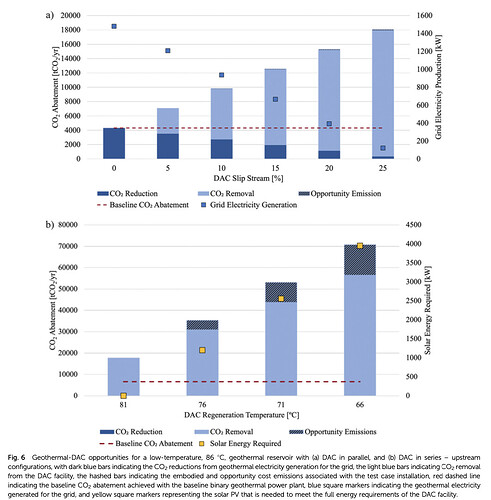Advancing geothermal energy utilization opportunities: potential and strategies for integrating direct air capture
This week, we deep dive into a paper recently published in Energy Environmental Science. The study was led by Maxwell Pisciotta, from the Chemical and Biomolecular Engineering Department of the University of Pennsylvania in Philadelphia (United States).
This study explores novel frameworks for using low-enthalpy geothermal resources not only to generate electricity but also to power direct air capture (DAC) systems, aiming to maximize CO₂ abatement per geothermal well. Geothermal energy has long been used in the past and is still harnessed for low-grade heat applications, district heating, and low-carbon electricity generation, currently contributing over 13 GW to the global electricity supply. However, its potential for CO₂ abatement extends beyond power production. The authors present a geothermal-DAC framework that explores how binary geothermal plants can be co-designed with DAC systems to maximize the efficiency and climate impact of geothermal resources.
To fully unlock geothermal energy’s climate potential, the authors move beyond the conventional approach of using leftover geothermal heat for DAC. Instead, they propose three alternative integration strategies—parallel, upstream, and downstream—each offering distinct trade-offs in how heat is allocated between electricity generation and CO₂ removal. By modeling these configurations across a range of geothermal resource temperatures, the study shows how system design strongly influences both carbon removal potential and power output.
Critically, the analysis incorporates detailed thermal and carbon accounting, ensuring that geothermal reservoirs are used sustainably, avoiding over-extraction of heat that could degrade long-term performance. A case study of the Raft River geothermal plant highlights how even mid-temperature resources can be effectively retrofitted for hybrid use. Results show that integrating geothermal energy with direct air capture (DAC) systems can significantly boost CO₂ removal compared to using geothermal energy for electricity alone, with improvements ranging from 5% to 757%, depending on the resource and configuration. Techno-economic analysis showed that the levelized cost of energy delivered to DAC (LCOEDAC) ranged widely, from $101 to $8,579 per ton of CO₂ captured.
This integrated framework offers a practical and scalable path to co-deploying DAC with geothermal systems in a way that maximizes climate benefit while maintaining resource viability, with flexible design options suited to a range of resource types and site conditions. Moreover, it shows that even existing geothermal plants can be retrofitted for hybrid use, expanding the potential for deployment. By emphasizing thermal sustainability and providing clear economic metrics, the framework supports informed decisions about when to prioritize clean power versus carbon removal, helping guide both policy and investment in climate-focused energy systems.
Here is a list of the main takeaways of this paper:
- Geothermal–DAC integration offers more than waste heat use: The study explores three system configurations that actively co-optimize power generation and CO₂ removal.
- System design strongly affects performance: Resource temperature, plant layout, and heat allocation influence both carbon capture efficiency and electricity output.
- Sustainable thermal use is essential: Reinjection temperatures must be managed carefully to maintain long-term geothermal reservoir viability.
- Retrofitting is feasible and impactful: Mid-temperature sites, like Raft River, can be adapted for hybrid use, broadening the deployment potential.
- Techno-economic metrics guide decision-making: Levelized cost and CO₂ removal efficiency help determine when to prioritize DAC vs. clean power.
Read the full paper here: Advancing geothermal energy utilization opportunities: potential and strategies for integrating direct air capture
